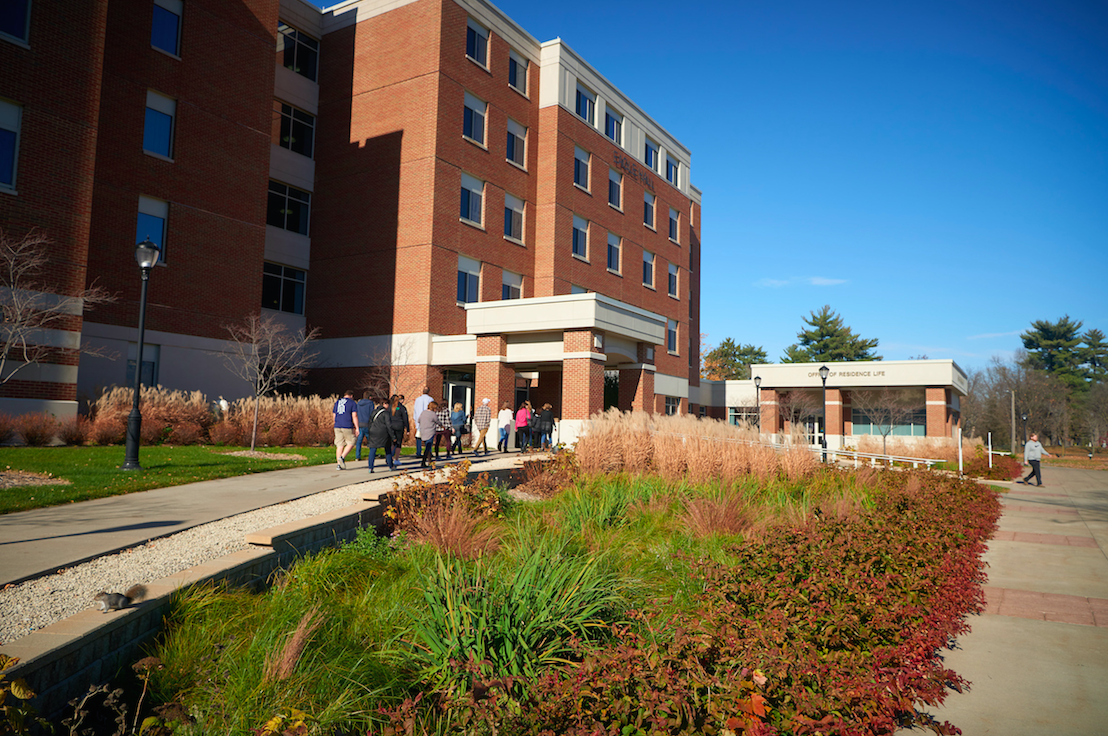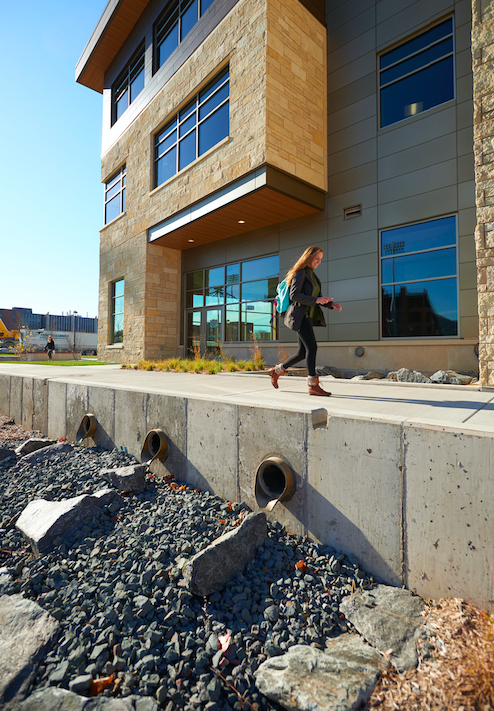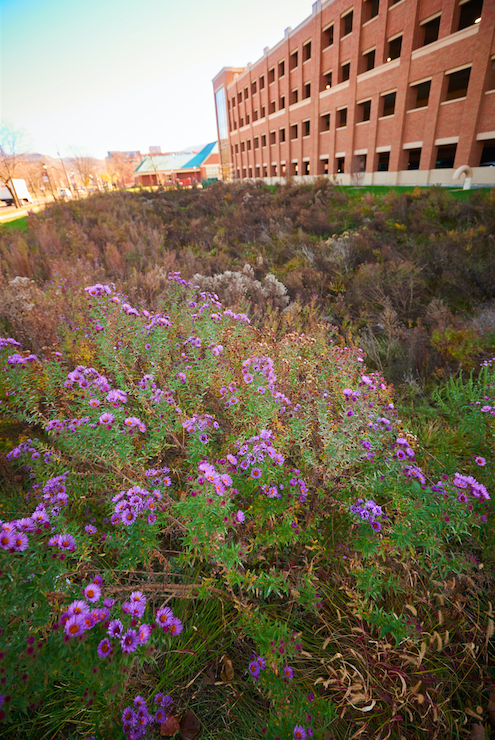Posted 4:34 p.m. Tuesday, Nov. 15, 2016

UWL’s storm water management improves environment, public safety.
UWL’s storm water management improves environment, public safety
Look around the UW-La Crosse campus and you’ll see a visible commitment to sustainability. It’s in the energy-efficient buildings. It’s even in the ground. UWL has improved the quality of its storm water runoff — rain or snow melt that runs off land or paved surfaces into waterways and can carry pollutants along with it. UWL Facilities Planning and Management has installed storm water management technologies around campus, and is in full compliance with U.S. Environmental Protection Agency and Wisconsin Department of Natural Resources storm water requirements. [caption id="attachment_47353" align="alignright" width="1108"] This rain garden outside of Eagle Hall is one of many across campus, which catch rain and snowmelt from roofs.[/caption]
Each major construction project over the last several years has incorporated features to improve water quality and reduce the quantity of runoff entering the storm sewer conveyance system. This improves the environment and public safety, says Dan Sweetman, UWL’s safety and sustainability manager. One of the most visible features is rain gardens around buildings, which catch rain and snowmelt from roofs. When water from UWL buildings is directed into rain gardens, it does not enter the underground storm sewer system pipes that lead to the Black, La Crosse, and Mississippi Rivers. Beside the inherent benefit of improving water quality, these rain gardens help reduce street flooding on and around UWL that would result from full storm sewer pipes.
Rain gardens are part of the landscaping around Eagle Hall, Centennial Hall, the New Student Union, Parking Ramp/Police Services building, the Recreational Eagle Center and several parking lots.
[caption id="attachment_47355" align="alignright" width="350"]
This rain garden outside of Eagle Hall is one of many across campus, which catch rain and snowmelt from roofs.[/caption]
Each major construction project over the last several years has incorporated features to improve water quality and reduce the quantity of runoff entering the storm sewer conveyance system. This improves the environment and public safety, says Dan Sweetman, UWL’s safety and sustainability manager. One of the most visible features is rain gardens around buildings, which catch rain and snowmelt from roofs. When water from UWL buildings is directed into rain gardens, it does not enter the underground storm sewer system pipes that lead to the Black, La Crosse, and Mississippi Rivers. Beside the inherent benefit of improving water quality, these rain gardens help reduce street flooding on and around UWL that would result from full storm sewer pipes.
Rain gardens are part of the landscaping around Eagle Hall, Centennial Hall, the New Student Union, Parking Ramp/Police Services building, the Recreational Eagle Center and several parking lots.
[caption id="attachment_47355" align="alignright" width="350"] UWL’s new student union has numerous drain inlets on its flat roof. These drains are connected to pipes within the building that divert all rain and snowmelt from the roof into the rain gardens via these visible outfall pipes. The roof has a surface area of 53,652 square feet, so a one inch rain event will divert roughly 33,500 gallons of water into the rain gardens. Rocks just below the pipes prevent erosion and damage to the plantings during a heavy rain.[/caption]
Without storm water management features in developed areas, water would not naturally soak into the ground, but would instead run rapidly into storm drains, sewer systems and drainage ditches. In addition to flooding, this can cause:
UWL’s new student union has numerous drain inlets on its flat roof. These drains are connected to pipes within the building that divert all rain and snowmelt from the roof into the rain gardens via these visible outfall pipes. The roof has a surface area of 53,652 square feet, so a one inch rain event will divert roughly 33,500 gallons of water into the rain gardens. Rocks just below the pipes prevent erosion and damage to the plantings during a heavy rain.[/caption]
Without storm water management features in developed areas, water would not naturally soak into the ground, but would instead run rapidly into storm drains, sewer systems and drainage ditches. In addition to flooding, this can cause:
- Stream bank erosion
- Increased turbidity (muddiness created by stirred up sediment) from erosion
- Habitat destruction
- Combined sewer overflows
- Infrastructure damage
- Contaminated streams, rivers and coastal water
How you can help
[caption id="attachment_47360" align="alignright" width="350"] This rain garden outside of UWL’s new parking ramp is attractive and functional.[/caption]
UWL Facilities Planning and Management will continue taking actions that improve storm water quality, but water quality on campus and in the region can only be protected and improved with your help! Please read and employ techniques described in UWL’s "Doing Your Part" guidelines.
As part of FP&M’s commitment to sustainability, documents related to UWL’s Storm Water Management commitment are available at www.uwlax.edu/ehs/storm_water.htm.
For additional information related to UWL’s storm water pollution prevention program, or to report one-time or ongoing issues that could negatively impact storm water quality, contact Dan Sweetman at dsweetman@uwlax.edu or call 608.785.6800.
This rain garden outside of UWL’s new parking ramp is attractive and functional.[/caption]
UWL Facilities Planning and Management will continue taking actions that improve storm water quality, but water quality on campus and in the region can only be protected and improved with your help! Please read and employ techniques described in UWL’s "Doing Your Part" guidelines.
As part of FP&M’s commitment to sustainability, documents related to UWL’s Storm Water Management commitment are available at www.uwlax.edu/ehs/storm_water.htm.
For additional information related to UWL’s storm water pollution prevention program, or to report one-time or ongoing issues that could negatively impact storm water quality, contact Dan Sweetman at dsweetman@uwlax.edu or call 608.785.6800.
